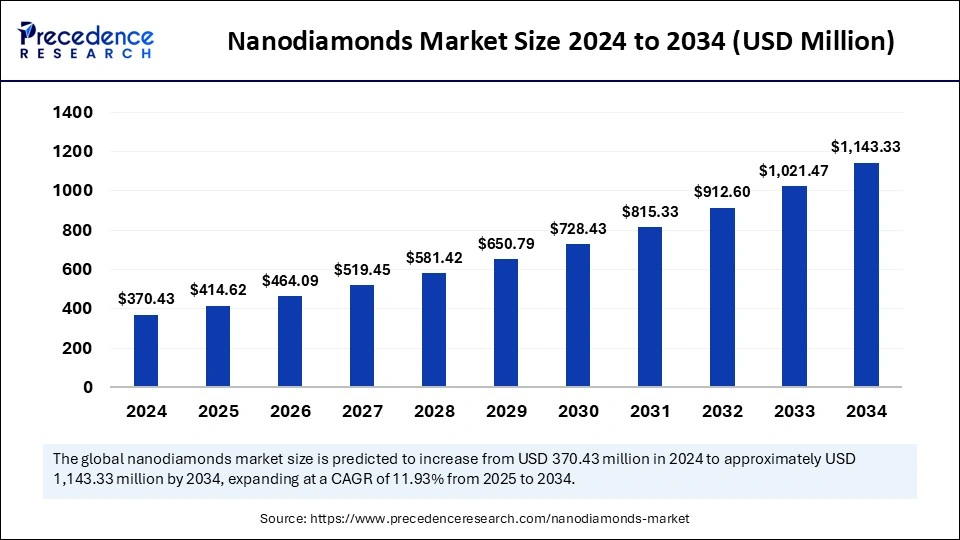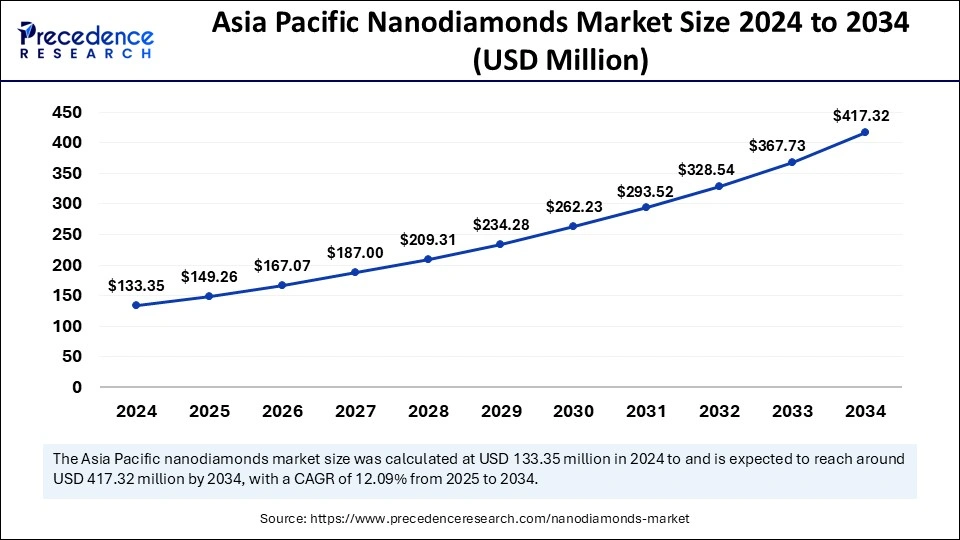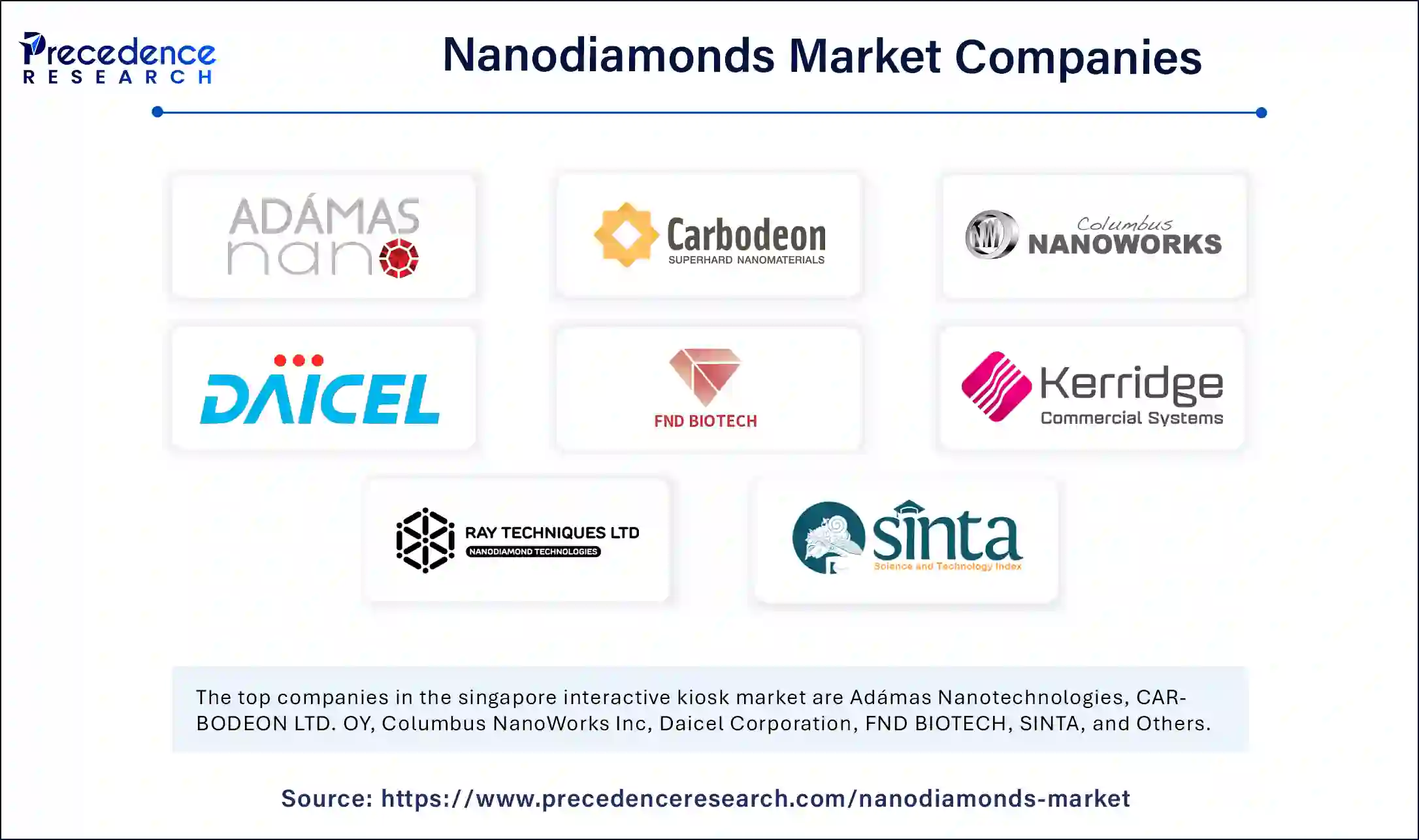The global nanodiamonds market size is calculated at USD 414.62 million in 2025 and is forecasted to reach around USD 1,143.33 million by 2034, accelerating at a CAGR of 11.93% from 2025 to 2034. The Asia Pacific market size surpassed USD 133.35 million in 2024 and is expanding at a CAGR of 12.09% during the forecast period. The market sizing and forecasts are revenue-based (USD Million/Million), with 2024 as the base year.
The global nanodiamonds market size was estimated at USD 370.43 million in 2024 and is predicted to increase from USD 414.62 million in 2025 to approximately USD 1,143.33 million by 2034, expanding at a CAGR of 11.93% from 2025 to 2034. The market growth is driven by the rising adoption of nanodiamonds in electronics and high-performance industrial coatings. Moreover, technological advancements and increasing research initiatives support market growth.

Artificial Intelligence enhances nanodiamond synthesis by minimizing defects and achieving uniform particle sizes, which improves their capabilities in both drug delivery and quantum computational systems. Machine learning models with advanced capabilities speed up research by predicting material properties and enhancing experimental processes. This, in turn, reduces both resource usage and time required for research. AI led to developments in material science, leading to improved yield of nanodiamonds with desired characteristics.
Asia Pacific nanodiamonds market size was exhibited at USD 133.35 million in 2024 and is projected to be worth around USD 417.32 million by 2034, growing at a CAGR of 12.09% from 2025 to 2034.

Asia Pacific dominated the nanodiamonds market by holding the largest share in 2024, owing to the growing support from the public sector to speed up the commercialization of nanodiamonds. The Chinese Academy of Sciences (CAS) dedicates financial support to nanodiamond investigation, which explores their uses in energy storage, coating development, and biomedical applications.
The Japanese Ministry of Economy, Trade, and Industry (METI) implements distinct nanotechnology support measures for semiconductor development and quantum computing advancement. The South Korean research community and private companies establish joint ventures to incorporate nanodiamonds into medical imaging technologies and diagnostic instruments. There is a strong focus on nanotechnology research, which further supports the market. Nanodiamond technology spreads throughout electronics production facilities, healthcare operations, and coating applications.

The North American nanodiamonds market is anticipated to grow at the fastest rate during the forecast period. This region possesses advanced technological infrastructure and strong R&D activities, expanding nanodiamond applications. Nanodiamond applications in American industries reached high levels through their integration into electronic products, healthcare devices, and automotive components. The market is growing due to the rising government funding for nanomaterials research and the strong presence of nanotechnology companies.
Canada can have a stronghold on the market due to growing research efforts toward advanced materials and nanotechnology. Through programs from the National Research Council Canada (NRC) and other government entities, the development of nanomaterials and their applications in biomedical fields have increased. The Canadian Institutes of Health Research (CIHR) continuously provides funding to multiple research projects focusing on nanodiamonds for medical applications, which supports the market. Furthermore, the Mexican government’s initiatives to boost high-tech manufacturing capabilities boost the market in North America.
The nanodiamonds market is experiencing rapid growth due to their increasing applications in various industries, including healthcare, pharmaceuticals, cosmetics, and electronics. Nanodiamonds are sub-microscopic materials with sizes ranging between 1 and 100 nanometers. Nanodiamonds exhibit excellent mechanical traits with electrical resistance and thermal conductivity properties, making them suitable for a range of applications. They serve biomedical applications for drug delivery systems, imaging, and biosensing purposes to enhance treatment results and diagnostic precision.
Nanodiamonds provide enhanced thermal management capabilities that specifically benefit electronic devices while extending their operational life. Synthesis technology improvements through detonation and high-pressure, high-temperature methods enhance production scalability, which enables wider commercial use. Nanodiamonds have established themselves as essential components in next-generation technological solutions, delivering both performance benefits and sustainability features to industries.
| Report Coverage | Details |
| Market Size by 2034 | USD 1,143.33 Million |
| Market Size in 2025 | USD 414.62 Million |
| Market Size in 2024 | USD 370.43 Million |
| Market Growth Rate from 2025 to 2034 | CAGR of 11.93% |
| Dominating Region | Asia Pacific |
| Fastest Growing Region | North America |
| Base Year | 2024 |
| Forecast Period | 2025 to 2034 |
| Segments Covered | Product, End-use, and Regions. |
| Regions Covered | North America, Europe, Asia-Pacific, Latin America, and the Middle East & Africa. |
Growing Applications in Biomedical Imaging and Diagnostics
The rising utilization of nanodiamonds in biomedical imaging and diagnostics is driving the growth of the nanodiamonds market. Nanoparticles boost diagnostic efficiency by enabling continuous disease recognition for improved treatment success in oncology. Nanodiamond-based biosensors allow the discovery of cancer and infectious disease biomarkers, which boosts their acceptance for early-stage diagnostic procedures.
Government support for medical nanotechnology through increased funding, along with intensified research institutions and biotech firm partnerships, drives technological progress. Such initiatives reflect a broader trend of increasing support for biomedical innovations, including nanodiamond applications in imaging and diagnostics. Moreover, the increasing number of people suffering from chronic diseases, including cardiovascular diseases, cancers, diabetes, and chronic respiratory diseases, further fuels the demand for advanced biomedical imaging technology equipped with nanodiamond technology.
Competition from Alternative Nanomaterials and High Costs
Competition from alternative nanomaterials is anticipated to hamper the growth of the nanodiamonds market. Nanomaterials such as graphene, carbon nanotubes, and silica-based nanoparticles offer similar advantages in drug delivery, coatings, and electronic applications, limiting the use of nanodiamonds. Alternative nanomaterials maintain a competitive edge as they establish supply chains and scientific research evidence, and offer cheaper production possibilities in certain applications. Moreover, producing nanodiamonds requires substantial investments due to their complex manufacturing process. This further restrains market growth.
Rising Investments in Sustainable and Green Nanotechnology
The rising investments in sustainable and green nanotechnology are expected to create immense opportunities in the nanodiamonds market. Green nanotechnology focuses on the development of sustainable methods for producing nanodiamonds. Nanodiamonds are increasingly being explored for their potential in developing sustainable materials and environmental remediation. The high surface area of nanodiamonds, combined with their catalytic properties, makes them highly useful for water purification, energy storage, and carbon capture applications. Scientists evaluate nanodiamonds for their ability to improve the performance of both fuel cells and advanced filtration systems that enhance the efficiency and sustainability of these technologies. The substantial investments show escalating interest in sustainable innovations, which positions nanodiamonds as important in developing green technology solutions. As industries prioritize eco-friendly materials with minimal environmental impact, the demand for green nanotechnology increases.
The detonation nanodiamonds (DNDs) segment held the dominant share of the nanodiamonds market in 2024, as they provide both affordable operations and versatile performance across different industries. The controlled detonation of carbon-filled explosives produces nanodiamonds with high surface area and outstanding hardness at an optimal size. Detonation nanodiamonds have gained immense traction due to their broad application in abrasive fields, coating materials, lubricants, and biomedical areas. Their excellent chemical and physical properties make them suitable for various applications. Furthermore, the commercialization of nanomaterials has been boosted by increasing research financing, together with industrial partnerships and institutional collaborations.
The chemical vapor deposition (CVD) nanodiamonds segment is projected to expand at the highest CAGR in the coming years. This is mainly due to the rising applications of CVD nanodiamonds in biomedical imaging. The CVD method gives researchers full control over nanodiamond dimensions, production quality, and characteristics. These nanodiamonds are preferred for their superior thermal conductivity and durability. Semiconductor manufacturing businesses and research institutions are dedicating funds to CVD nanodiamond synthesis as they seek to develop better quantum sensors and next-generation computing systems.
The healthcare & pharmaceutical segment held the revenue share of the nanodiamonds market in 2024. Nanotechnology has gradually become more prevalent in drug delivery, imaging systems, and other medical technologies. Nanodiamonds enable drug solutions to maintain better stability while helping target medications directly to therapeutic areas to decrease the occurrence of adverse side effects. Nanodiamonds enable multiple functional group attachments, so the therapeutic agents form chemical bonds to enhance drug delivery. The heating properties of nanodiamonds under laser radiation make them suitable for testing in tumor therapy hyperthermia applications.
The electronics segment is expected to grow at the highest CAGR over the studied period. Nanodiamonds play an important role in thermal management applications and serve as a microchip polishing and science-based dielectric material. The unique characteristics of nanodiamonds, including outstanding durability and thermal heat transfer capabilities, make them instrumental in enhancing the functionalities of electronic devices. Nanodiamonds reduce heat dissipation from power and optoelectronic devices, enhancing performance and longevity. Nanodiamond synthesis techniques have developed to such an extent that they enable new applications within the electronic sector, boosting segmental growth.

By Product
By End-use
By Region
For inquiries regarding discounts, bulk purchases, or customization requests, please contact us at sales@precedenceresearch.com
No cookie-cutter, only authentic analysis – take the 1st step to become a Precedence Research client